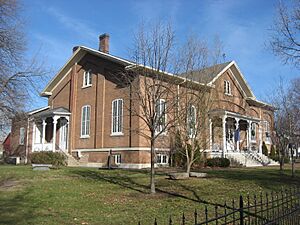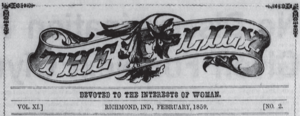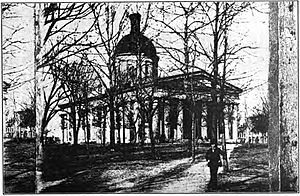Mary Birdsall facts for kids
Quick facts for kids
Mary Birdsall
|
|
|---|---|
| Born |
Mary B. Thistlethwaite
1828 Chester, PA
|
| Died | February 1, 1894 (aged 65-66) |
| Resting place | Earlham Cemetery |
| Known for | Suffragist |
| Spouse(s) | Thomas Birdsall (married 1848-1894) |
| Children | Alvin T. Birdsall (1849 - 1875)
William W. Birdsall (1854 - 1909) Hubert H. Birdsall (1856 - ?) |
| Parent(s) | William Thistlethwaite; Elizabeth Wetherald |
Mary B. Thistlethwaite Birdsall (1828–1894) was an important American woman who worked for equal rights. Born in Pennsylvania, she grew up on a farm in Richmond, Indiana. In 1848, she married Thomas Birdsall, and they had three sons. Mary Birdsall was a journalist, a leader for women's voting rights (called a suffragist), and a supporter of the temperance movement (which aimed to reduce alcohol use).
She started her writing career as the women's editor at the Indiana Farmer newspaper. Later, she owned The Lily, a newspaper for women, which she bought from another suffragist, Amelia Bloomer, in 1854. Mary Birdsall helped organize the second women's rights convention in Indiana. She became the secretary and later the president of the Indiana Woman's Suffrage Association. In 1859, she was one of the first three women to speak to the Indiana legislature, asking for women to have the right to vote. Mary Birdsall passed away in Philadelphia in 1894. Her home in Richmond, Indiana, is now a historic landmark.
Contents
Early Life and Family
Mary B. Thistlethwaite was born in 1828 in Chester, Pennsylvania. She was the sixth of eight children. Her father, William Thistlethwaite, was a farmer from England. He and Mary's mother, Elizabeth Wetherald, moved to America in 1817.
After living in Delaware and Cincinnati for a short time, her family moved to Richmond, Indiana, in 1829. They settled on a farm near the town in 1830. Mary's father was a successful farmer. Some of her family were active in the Quakers, a religious group.
Marriage and Children
On October 26, 1848, when she was 19, Mary married Thomas Birdsall. He was also a farmer and a Quaker. They were married at the Whitewater Monthly Meeting in Richmond.
Mary and Thomas Birdsall had three sons. Their oldest son, Alvin T. Birdsall, was born in 1849. He passed away at age 25 in Brooklyn, New York. Their second son, William Wilfred Birdsall (born 1854), became an educator and writer. He was even president of Swarthmore College for a time. William and his wife had three sons, who were likely Mary Birdsall's only grandchildren. Their third son, Hubert H. Birdsall (born 1856), also attended Earlham College and became a journalist in Philadelphia.
Journalism Career
Writing for the Indiana Farmer
The Indiana Farmer newspaper started in Richmond in 1851. It focused on farming, gardening, and useful crafts. In October 1852, the newspaper created a "Ladies' Department," and Mary Birdsall was hired to edit it.
She quickly began promoting ideas for women's rights. Her section also covered topics like home economics and state fairs. Mary encouraged women to read and support newspapers run by women. She wrote articles urging women to learn more and find challenging jobs. She believed this would help their families, not take away from their roles as wives and mothers. Her time at the Indiana Farmer was short, ending in March 1853.
Leading The Lily Newspaper
Around 1848, a women's temperance group in Seneca Falls, New York, wanted to start their own newspaper. Amelia Bloomer took over the project and started The Lily. This newspaper was probably the first one focused on women and entirely published by women. At first, it focused on temperance. But Amelia Bloomer soon began writing about women's rights. The newspaper became very popular, especially after she promoted a new style of dress (Turkish pantaloons and a short skirt, known as "bloomers").
Amelia Bloomer met Mary Birdsall at a women's rights convention in 1853. In late 1854, Bloomer sold The Lily to Mary Birdsall. Mary became the editor and owner in January 1855. She was helped by Mary F. Thomas, another suffragist from Richmond. They continued to publish articles about women's rights and voting until at least 1859.
While Mary Birdsall worked at the Indiana Farmer and The Lily, both newspapers reached about 3,000 readers.
Working for Women's Rights
Indiana Women's Rights Conventions
Like many Quakers, the Birdsalls were involved in several social movements. These included temperance, women's voting rights (suffrage), and ending slavery (abolition).
The first Indiana women's rights convention was held in October 1851. Mary Birdsall served as the secretary for this meeting. She also helped organize the second convention in Richmond the next year. At that meeting, she and her husband signed papers to form the Woman's Rights Association of Indiana. Mary was elected secretary and held this position for several years.
At the second convention, attendees discussed and passed many ideas to give women equal status with men. They believed women should receive the same education as men. They also encouraged women to have jobs to support themselves and receive equal pay for equal work. Mary Birdsall wrote down the meeting notes and sent them to several newspapers.
Mary Birdsall was also a vice president at the fourth National Women's Rights Convention in Cleveland, Ohio, in 1853. The Indiana conventions continued, and in 1858, the meeting returned to Richmond, largely thanks to Mary's efforts. During this meeting, the group wrote a petition to the Indiana General Assembly asking for women's rights. At the ninth convention in 1859, Mary Birdsall was elected president of the association.
Speaking to the Indiana Legislature
On January 19, 1859, the Indiana House and Senate met together in a special session. Mary F. Thomas, Mary Birdsall, and Agnes Cook were given special seats. They presented a petition asking for women's rights. They were the first women to speak to the state legislature. More than a thousand people had signed the petition.
Mary F. Thomas spoke first, reading the petition aloud. The petition simply asked for women to have equal property rights and the right to vote. Mary Birdsall spoke next for about half an hour. Her speech was described as a "clear and logical plea" for women's right to vote. She argued that women could not truly improve their lives without equal rights. She also said that any "inferior" qualities in women were due to a lack of opportunities, not a reason to deny them rights. She believed voting was the only way for women to protect themselves.
Agnes Cook finished their remarks, explaining how women with voting rights could better help the temperance movement. After their speeches, the legislature discussed the petition. However, they decided not to take any further action. Even though the legislature did not grant women their requests, the efforts of these three suffragists helped other women in Indiana continue the fight for the right to vote.
The Mary Birdsall House
Construction of the Mary Birdsall House began in 1859 and finished in 1860. The Birdsalls called their home "Brightbank." This Italianate style house is in Richmond, Indiana. It looks very similar to a house plan published in a book by Catherine Beecher and Harriett Beecher Stowe in 1872. Their book promoted a scientific way to design homes.
In 1927, the Quakers bought the house. They named it Lauramoore and used it as a retirement home for older people. They also used it as a temporary meeting place for worship. The house was expanded with more rooms. In 2010, Earlham College took ownership of Lauramoore. It is now known as the Lauramoore Guest House and Retreat Center. In 1999, the house was listed on the National Register of Historic Places, recognizing its historical importance. In 2012, a plaque honoring Mary Birdsall was placed at the property.
Later Life
Mary Birdsall continued her community work. She helped form the Union Relief Association, which found jobs for people in need. This group also started a home for orphans and other children who needed help. Her husband, Thomas Birdsall, was also active in the community and helped form the Richmond Temperance Society.
Mary Birdsall stopped attending Quaker meetings around 1869. In 1872, she formally left the religion. The Birdsalls moved to Philadelphia, Pennsylvania, by 1880. Thomas Birdsall ran a farming supply business there with his sons.
Mary Birdsall passed away suddenly in Philadelphia on February 1, 1894. Her body was brought back to Richmond for burial. She was buried in Earlham Cemetery in Richmond. Thomas Birdsall passed away in 1901 and was buried next to Mary.





